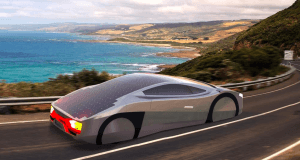The Immortus is based on solar race car technology with the project originally founded by Australia’s Aurora Solar Car Team, which has competed in a bunch of solar race events across the world. Hence the light weight and the shape of the Immortus, which combines maximal sun exposure with extreme aerodynamics, including covered wheels.
Unlike the solar racers, though, it’s designed to approach practicality on the road, with a 0-100 km/h (62 mph) time that will be less than seven seconds and a top speed over 150 km/h (93 mph). It’s also a two-seater with a modest luggage capacity for daily driving. Melbourne-based EVX Ventures, creators of the Immortus, even list fun as a priority, saying it should handle like a well-balanced sports car.
Squeezing unlimited range from solar energy
Where the Tesla Model S has a massive 85 kWh battery pack, the self-replenishing system on the Immortus uses only a 10 kWh lithium-ion phosphate battery. The car uses twin DC motors mounted on the uprights leading to each rear wheel hub, each with a peak output of 20 kW, for a total peak output of 40 kW (53.6 hp). While 40 kW doesn’t sound like much, the entire car has been designed to make the most of its power. A feather-light weight of around 550 kg (1,212 lb) gives the Immortus a power-to-weight ratio and acceleration time similar to a Mazda MX5 (aka Miata), and the weight distribution is designed to offer similarly sporty handling characteristics.
The Mazda will out-corner it though, because the Immortus won’t use regular road tires. It’ll use tires specifically designed for solar racers, very thin wheels with low-friction tires that prioritize low rolling resistance over grip. These aren’t the most attractive wheels, but then, they’re hidden away behind the aerodynamic wheel arch covers anyway. And thanks to exceptionally low weight, low-drag aerodynamics and low-friction, low-contact tires, EVX expects the car’s small 10 kWh battery pack to be good for just under 400 km (248 mi) worth of range even at night, when there’s no solar assistance topping it up. When the sun’s out and the road’s clear, that range goes up, effectively to infinity if you stay around 60 km/h (37 mph). Upping the pace to 85 km/h (53 mph) the range drops to about 550 km (342 mi).
Distributed manufacturing – every car a custom
Ease of construction is key for the Immortus team, because they don’t plan to mass-produce the car, or even to build it in-house.
“We’re not trying to be a Tesla,” says Barry Nguyen, CEO and co-founder of EVX Ventures. “Tesla is a mass manufacturer of cars, we’re designers of boutique custom electric cars and aftermarket products. There’s regulations in the US and Australia that allow for individually constructed vehicles. Essentially what that means is that if you contract a custom car builder with the designs and components, you can build a road legal car without the crash testing and the 5-10 million dollars you’d have to raise to do that. We plan to sell those cars in low volume.”
Thus, the Immortus has been designed to be exceptionally simple to assemble. Abandoning early concepts that used a carbon-fibre monocoque frame with two large tubs, the most recent design features an ultra-lightweight space frame using off-the-shelf carbon fiber tubing, with 3D-printed nodes to connect the tubes. The frame of the car is effectively like a big Meccano set.
“This simplifies the manufacturing process, as well as reducing transport costs,” says technical lead Clint Steele. “The plan is to have these cars assembled by custom car builders close to wherever the customer is. The custom shops can source their own carbon fiber tubing, and we can either send over the 3D-printed node parts or send over the designs so they can print them locally.”
EVX doesn’t expect to sell more than 100 of the Immortus. At an estimated AUD$500,000 (approx. US$370,000) depending on spec, it’s a boutique, high priced technology platform that will only appeal to extremely wealthy early adopters. But the ideas developed through the Immortus project are filtering out into a range of other projects that are much more consumer focused. EVX is looking to raise about US$1.5 million dollars to get the Immortus production ready, and will be taking a scaled-down, remote control version of the Immortus to SEMA in Las Vegas later in the year.
Either way, early as it is, the Immortus, along with the Stella Lux prototype from the Netherlands, paves the way for a new category of vehicle, one that’s all but energy independent. An electric car in which you rarely, if ever, have to think about where the next charge point is. A high-end, high tech sportscar you won’t want to keep in your garage, because it can’t get any sun in there. And as battery technology and photovoltaic efficiency continue to improve, these kinds of cars could become a lot more viable.


